SDG 11.3 Assessment of African Industrial Cities by Integrating Remote Sensing and Spatial Cooperative Simulation: With MFEZ in Zambia as a Case Study
Abstract
1. Introduction
2. Research Area and Data Sources
2.1. Research Area
2.2. Data Sources and Preprocessing
- (1)
- Landsat image dataset
- (2)
- Nighttime light (NTL) data
- (3)
- Additional geospatial data
3. Methods
3.1. Urban Expansion Analysis Using NTL
3.1.1. Threshold Determination with PIFs Method
3.1.2. Urban Growth Indicators
3.2. Simulation of Land-Use and Population Changes
3.2.1. Driving Factors of Land Use and Population
3.2.2. CA-Based Feature Simulation
3.2.3. Initial and Step-Wise Cooperative Simulation with CAFS
3.3. Accuracy Validation
3.4. Spatiotemporal Assessment of SDG 11.3.1 Indicator
4. Results
4.1. Spatial and Temporal Changes in Urban Expansion
4.1.1. Extracting Urban Built-Up Area from NTL Images Using PIFs Method
4.1.2. Calculation of the Spatial and Temporal Change Index for Urban Expansion
4.1.3. Characterization of Urban Expansion Standard Deviation Ellipse (SDE)
4.2. Synergistic Land-Use Population Modeling
4.2.1. Temporal and Spatial Variation in Land Use and Population
4.2.2. Spatial Cooperative Simulation of LULC-Population
4.3. Spatiotemporal Variation in Land Consumption and Population Growth (SDG 11.3.1)
5. Discussion
5.1. Effectiveness of Extracting Built-Up Areas Based on DMSP-OLS and NPP-VIIRS Data
5.2. Drivers of Significant Urban Expansion and Population Explosion
5.3. Analysis of Land-Use Simulation Results Under SDG Frame
5.4. Limitations and Future Perspectives
6. Conclusions
Author Contributions
Funding
Data Availability Statement
Acknowledgments
Conflicts of Interest
References
- Nations, U. Transforming Our World: The 2030 Agenda for Sustainable Development; United Nations, Department of Economic and Social Affairs: New York, NY, USA, 2015; Volume 1, p. 41. [Google Scholar]
- UN-HABITAT. Metadata on SDG Indicator 11.3.1. Available online: https://unhabitat.org/sites/default/files/2022/08/sdg_indicator_metadata-11.3.1.pdf (accessed on 7 August 2024).
- Akuraju, V.; Pradhan, P.; Haase, D.; Kropp, J.P.; Rybski, D. Relating SDG11 Indicators and Urban Scaling—An Exploratory Study. Sustain. Cities Soc. 2020, 52, 101853. [Google Scholar] [CrossRef]
- Forget, Y.; Shimoni, M.; Gilbert, M.; Linard, C. Mapping 20 Years of Urban Expansion in 45 Urban Areas of Sub-Saharan Africa. Remote Sens. 2021, 13, 525. [Google Scholar] [CrossRef]
- Xu, J.; Wang, X. Reversing Uncontrolled and Unprofitable Urban Expansion in Africa through Special Economic Zones: An Evaluation of Ethiopian and Zambian Cases. Sustainability 2020, 12, 9246. [Google Scholar] [CrossRef]
- Chibbonta, W.; Mayondi, M.; Mulenga, R. A REFLECTION ON ZAMBIA’S DEVELOPMENT STRATEGIES SINCE INDEPENDENCE-1964 TO 2021. Available online: https://www.multiresearch.net/cms/publications/CFP26582022.pdf (accessed on 7 August 2024).
- Mutale, I.; Franco, I.B.; Lamont, S. Zambia’s Mining Industry: A Closer Look at the Corporate Approaches to Sustainable Development of Konkola and Mopani Copper Mines. In Corporate Approaches to Sustainable Development; Franco, I.B., Ed.; Science for Sustainable Societies; Springer Nature: Singapore, 2022; pp. 73–88. ISBN 9789811664205. [Google Scholar]
- Zhou, M.; Lu, L.; Guo, H.; Weng, Q.; Cao, S.; Zhang, S.; Li, Q. Urban Sprawl and Changes in Land-Use Efficiency in the Beijing–Tianjin–Hebei Region, China from 2000 to 2020: A Spatiotemporal Analysis Using Earth Observation Data. Remote Sens. 2021, 13, 2850. [Google Scholar] [CrossRef]
- Wang, Y.; Huang, C.; Feng, Y.; Zhao, M.; Gu, J. Using Earth Observation for Monitoring SDG 11.3. 1-Ratio of Land Consumption Rate to Population Growth Rate in Mainland China. Remote Sens. 2020, 12, 357. [Google Scholar] [CrossRef]
- Gao, K.; Yang, X.; Wang, Z.; Zhang, H.; Huang, C.; Zeng, X. Spatial Sustainable Development Assessment Using Fusing Multisource Data from the Perspective of Production-Living-Ecological Space Division: A Case of Greater Bay Area, China. Remote Sens. 2022, 14, 2772. [Google Scholar] [CrossRef]
- Croft, T.A. Nighttime Images of the Earth from Space. Sci. Am. 1978, 239, 86–101. [Google Scholar] [CrossRef]
- Milesi, C.; Elvidge, C.D.; Nemani, R.R.; Running, S.W. Assessing the Impact of Urban Land Development on Net Primary Productivity in the Southeastern United States. Remote Sens. Environ. 2003, 86, 401–410. [Google Scholar] [CrossRef]
- Muthukrishnan, R.; Radha, M. Edge Detection Techniques for Image Segmentation. Int. J. Comput. Sci. Inf. Technol. 2011, 3, 259. [Google Scholar] [CrossRef]
- Su, Y.; Chen, X.; Wang, C.; Zhang, H.; Liao, J.; Ye, Y.; Wang, C. A New Method for Extracting Built up Urban Areas Using DMSP-OLS Nighttime Stable Lights: A Case Study in the Pearl River Delta, Southern China. GIScience Remote Sens. 2015, 52, 218–238. [Google Scholar] [CrossRef]
- Quarmby, N.A.; Cushnie, J.L. Monitoring Urban Land Cover Changes at the Urban Fringe from SPOT HRV Imagery in South-East England. Int. J. Remote Sens. 1989, 10, 953–963. [Google Scholar] [CrossRef]
- Wu, K.; Wang, X. Aligning Pixel Values of DMSP and VIIRS Nighttime Light Images to Evaluate Urban Dynamics. Remote Sens. 2019, 11, 1463. [Google Scholar] [CrossRef]
- Wei, Y.; Liu, H.; Song, W.; Yu, B.; Xiu, C. Normalization of Time Series DMSP-OLS Nighttime Light Images for Urban Growth Analysis with Pseudo Invariant Features. Landsc. Urban Plan. 2014, 128, 1–13. [Google Scholar] [CrossRef]
- Li, S.; Liu, X.; Li, X.; Chen, Y. Simulation Model of Land Use Dynamics and Application: Progress and Prospects. J. Remote Sens. 2017, 21, 329–340. [Google Scholar] [CrossRef]
- Liu, X.; Liang, X.; Li, X.; Xu, X.; Ou, J.; Chen, Y.; Li, S.; Wang, S.; Pei, F. A Future Land Use Simulation Model (FLUS) for Simulating Multiple Land Use Scenarios by Coupling Human and Natural Effects. Landsc. Urban Plan. 2017, 168, 94–116. [Google Scholar] [CrossRef]
- Liang, X.; Guan, Q.; Clarke, K.C.; Liu, S.; Wang, B.; Yao, Y. Understanding the Drivers of Sustainable Land Expansion Using a Patch-Generating Land Use Simulation (PLUS) Model: A Case Study in Wuhan, China. Comput. Environ. Urban Syst. 2021, 85, 101569. [Google Scholar] [CrossRef]
- Shang, S.; Du, S.; Du, S.; Zhu, S. Estimating Building-Scale Population Using Multi-Source Spatial Data. Cities 2021, 111, 103002. [Google Scholar] [CrossRef]
- Yu, Y.; Yu, M.; Lin, L.; Chen, J.; Li, D.; Zhang, W.; Cao, K. National Green GDP Assessment and Prediction for China Based on a CA-Markov Land Use Simulation Model. Sustainability 2019, 11, 576. [Google Scholar] [CrossRef]
- Guzman, L.A.; Camacho, R.; Herrera, A.R.; Beltrán, C. Modeling Population Density Guided by Land Use-Cover Change Model: A Case Study of Bogotá. Popul. Environ. 2022, 43, 553–575. [Google Scholar] [CrossRef]
- Levin, N.; Kyba, C.C.; Zhang, Q.; de Miguel, A.S.; Román, M.O.; Li, X.; Portnov, B.A.; Molthan, A.L.; Jechow, A.; Miller, S.D. Remote Sensing of Night Lights: A Review and an Outlook for the Future. Remote Sens. Environ. 2020, 237, 111443. [Google Scholar] [CrossRef]
- Baugh, K.; Elvidge, C.D.; Ghosh, T.; Ziskin, D. Development of a 2009 Stable Lights Product Using DMSP-OLS Data. Proc. Asia-Pac. Adv. Netw. 2010, 30, 114. [Google Scholar] [CrossRef]
- Bian, J.; Li, A.; Lei, G.; Zhang, Z.; Nan, X.; Liang, L. Inter-Calibration of Nighttime Light Data between DMSP/OLS and NPP/VIIRS in the Economic Corridors of Belt and Road Initiative. In Proceedings of the IGARSS 2019—2019 IEEE International Geoscience and Remote Sensing Symposium, Yokohama, Japan, 28 July–2 August 2019; pp. 9028–9031. [Google Scholar]
- Xie, Y.; Weng, Q. Updating Urban Extents with Nighttime Light Imagery by Using an Object-Based Thresholding Method. Remote Sens. Environ. 2016, 187, 1–13. [Google Scholar] [CrossRef]
- Liu, L.; Liu, J.; Liu, Z.; Xu, X.; Wang, B. Analysis on the Spatio-Temporal Characteristics of Urban Expansion and the Complex Driving Mechanism: Taking the Pearl River Delta Urban Agglomeration as a Case. Complexity 2020, 2020, 8157143. [Google Scholar] [CrossRef]
- Baojun, W.; Bin, S.; Inyang, H.I. GIS-Based Quantitative Analysis of Orientation Anisotropy of Contaminant Barrier Particles Using Standard Deviational Ellipse. Soil Sediment Contam. Int. J. 2008, 17, 437–447. [Google Scholar] [CrossRef]
- Zhong Yang, Z.Y.; Lin AiWen, L.A.; Zhou ZhiGao, Z.Z. Evolution of the Pattern of Spatial Expansion of Urban Land Use in the Poyang Lake Ecological Economic Zone. Int. J. Environ. Res. Public Health 2019, 16, 117. [Google Scholar] [CrossRef]
- Tu, W.; Gao, W.; Li, M.; Yao, Y.; He, B.; Huang, Z.; Zhang, J.; Guo, R. Spatial Cooperative Simulation of Land Use-Population-Economy in the Greater Bay Area, China. Int. J. Geogr. Inf. Sci. 2024, 38, 381–406. [Google Scholar] [CrossRef]
- Huang, C.; Zhou, Y.; Wu, T.; Zhang, M.; Qiu, Y. A Cellular Automata Model Coupled with Partitioning CNN-LSTM and PLUS Models for Urban Land Change Simulation. J. Environ. Manag. 2024, 351, 119828. [Google Scholar] [CrossRef] [PubMed]
- Wang, J.; Bretz, M.; Dewan, M.A.A.; Delavar, M.A. Machine Learning in Modelling Land-Use and Land Cover-Change (LULCC): Current Status, Challenges and Prospects. Sci. Total Environ. 2022, 822, 153559. [Google Scholar] [CrossRef]
- Gao, L.; Tao, F.; Liu, R.; Wang, Z.; Leng, H.; Zhou, T. Multi-Scenario Simulation and Ecological Risk Analysis of Land Use Based on the PLUS Model: A Case Study of Nanjing. Sustain. Cities Soc. 2022, 85, 104055. [Google Scholar] [CrossRef]
- Jenks, G.F. The Data Model Concept in Statistical Mapping. Int. Yearb. Cartogr. 1967, 7, 186–190. [Google Scholar]
- Pontius, R.G. Quantification Error versus Location Error in Comparison of Categorical Maps (Vol 66, Pg 1011, 2000). Photogramm. Eng. Remote Sens. 2001, 67, 540. [Google Scholar]
- Pontius, R.G.; Boersma, W.; Castella, J.-C.; Clarke, K.; De Nijs, T.; Dietzel, C.; Duan, Z.; Fotsing, E.; Goldstein, N.; Kok, K.; et al. Comparing the Input, Output, and Validation Maps for Several Models of Land Change. Ann. Reg. Sci. 2008, 42, 11–37. [Google Scholar] [CrossRef]
- Chai, T.; Draxler, R.R. Root Mean Square Error (RMSE) or Mean Absolute Error (MAE). Geosci. Model Dev. Discuss. 2014, 7, 1525–1534. [Google Scholar]
- Li, C.; Cai, G.; Sun, Z. Urban Land-Use Efficiency Analysis by Integrating LCRPGR and Additional Indicators. Sustainability 2021, 13, 13518. [Google Scholar] [CrossRef]
- Deng, Y.; Qi, W.; Fu, B.; Wang, K. Geographical Transformations of Urban Sprawl: Exploring the Spatial Heterogeneity across Cities in China 1992–2015. Cities 2020, 105, 102415. [Google Scholar] [CrossRef]
- Sirko, W.; Kashubin, S.; Ritter, M.; Annkah, A.; Bouchareb, Y.S.E.; Dauphin, Y.; Keysers, D.; Neumann, M.; Cisse, M.; Quinn, J. Continental-Scale Building Detection from High Resolution Satellite Imagery. arXiv 2021, arXiv:2107.12283. [Google Scholar]
- Plc, K.I.L. ZCCM Investments Holdings Zambia—Copperbelt Environment Project: Environmental Impact Assessment. Available online: https://documents.worldbank.org/en/publication/documents-reports/documentdetail/152831468766181491/Zambia-Copperbelt-Environment-Project-environmental-impact-assessment (accessed on 7 July 2024).
- Huang, M.; Zhang, X. Construction of the Zambia–China Economic and Trade Cooperation Zone and South–South Cooperation. In South-South Cooperation and Chinese Foreign Aid; Huang, M., Xu, X., Mao, X., Eds.; Springer: Singapore, 2019; pp. 257–273. ISBN 9789811320019. [Google Scholar]
- Kapobe, J.; Mazala, C.; Phiri, R. Kitwe Black Mountain-Is Zambia Realising the True Value from It? J. Nat. Appl. Sci. 2019, 3, 62–72. [Google Scholar] [CrossRef]
- Okeyinka, Y. Housing in the Third World Cities and Sustainable Urban Developments. Dev. Ctry. Stud. 2014, 4, 112–120. [Google Scholar]
- Simwanda, M.; Murayama, Y.; Ranagalage, M. Modeling the Drivers of Urban Land Use Changes in Lusaka, Zambia Using Multi-Criteria Evaluation: An Analytic Network Process Approach. Land Use Policy 2020, 92, 104441. [Google Scholar] [CrossRef]
- Central Statistical Office Zambia. 2000 Census of Population and Housing. Available online: https://www.zamstats.gov.zm/wp-content/uploads/2023/12/2000-Census-of-population-and-housing-summary-report.pdf (accessed on 7 August 2024).
- Central Statistical Office Zambia. 2010 Census of Population and Housing. Available online: https://www.zamstats.gov.zm/wp-content/uploads/2023/12/National-Analytical-Report-2010-Census.pdf (accessed on 7 August 2024).
- Isbell, T.; Dryding, D. Zambians See Progress on Education Despite Persistent Inequalities. 2019. Available online: https://www.afrobarometer.org/wp-content/uploads/2022/02/ab_r7_dispatchno272_zambians_see_progress_on_education.pdf (accessed on 7 August 2024).
- Liu, S.; Yan, Y.; Hu, B. Satellite Monitoring of the Urban Expansion in the Pearl River–Xijiang Economic Belt and the Progress towards SDG11.3.1. Remote Sens. 2023, 15, 5209. [Google Scholar] [CrossRef]
- Mudau, N.; Mwaniki, D.; Tsoeleng, L.; Mashalane, M.; Beguy, D.; Ndugwa, R. Assessment of SDG Indicator 11.3. 1 and Urban Growth Trends of Major and Small Cities in South Africa. Sustainability 2020, 12, 7063. [Google Scholar] [CrossRef]
- Guan, Q.; Li, J.; Zhai, Y.; Liang, X.; Yao, Y. HashGAT-VCA: A Vector Cellular Automata Model with Hash Function and Graph Attention Network for Urban Land-Use Change Simulation. Landsc. Urban Plan 2024, 250, 105145. [Google Scholar] [CrossRef]
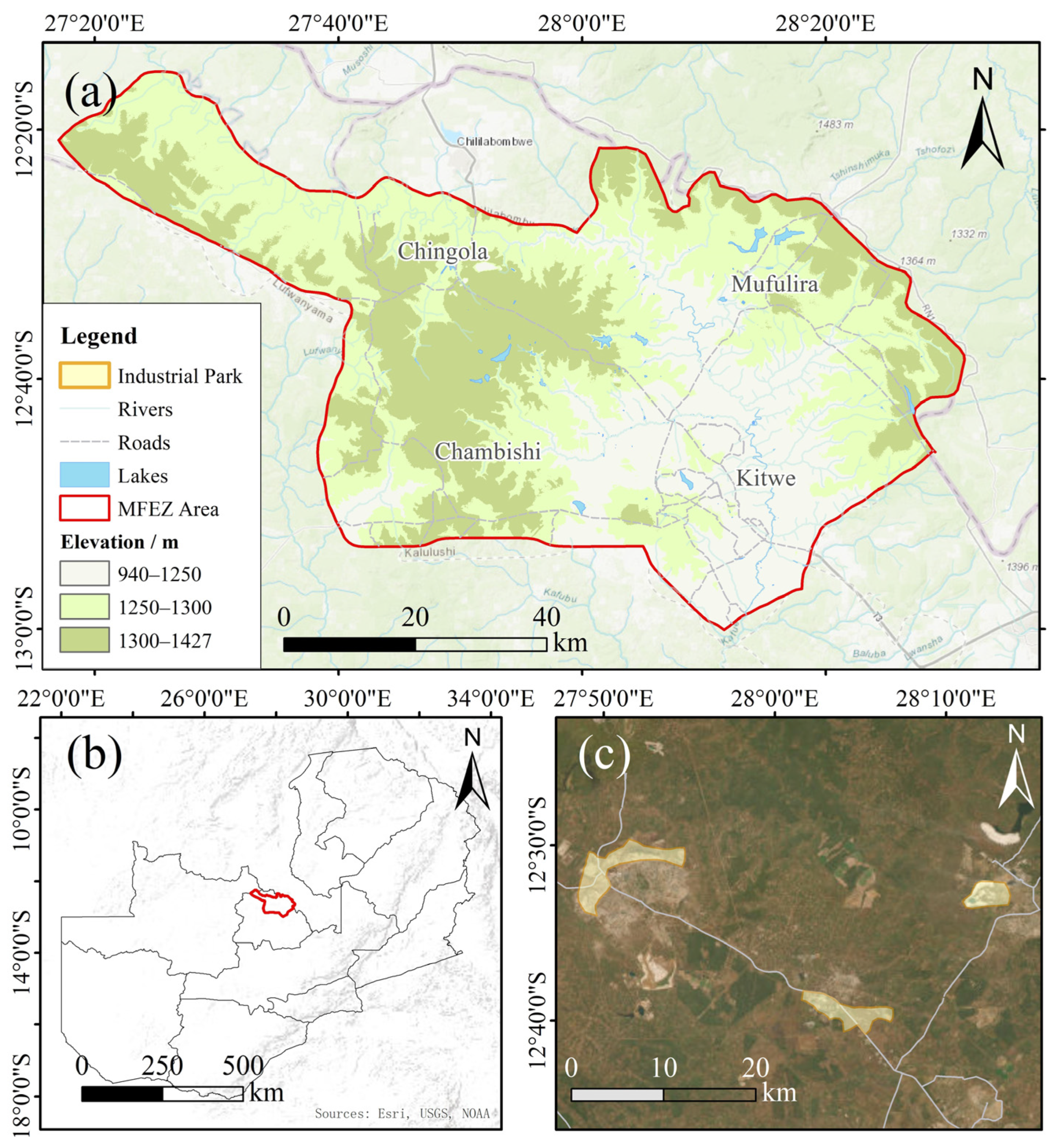

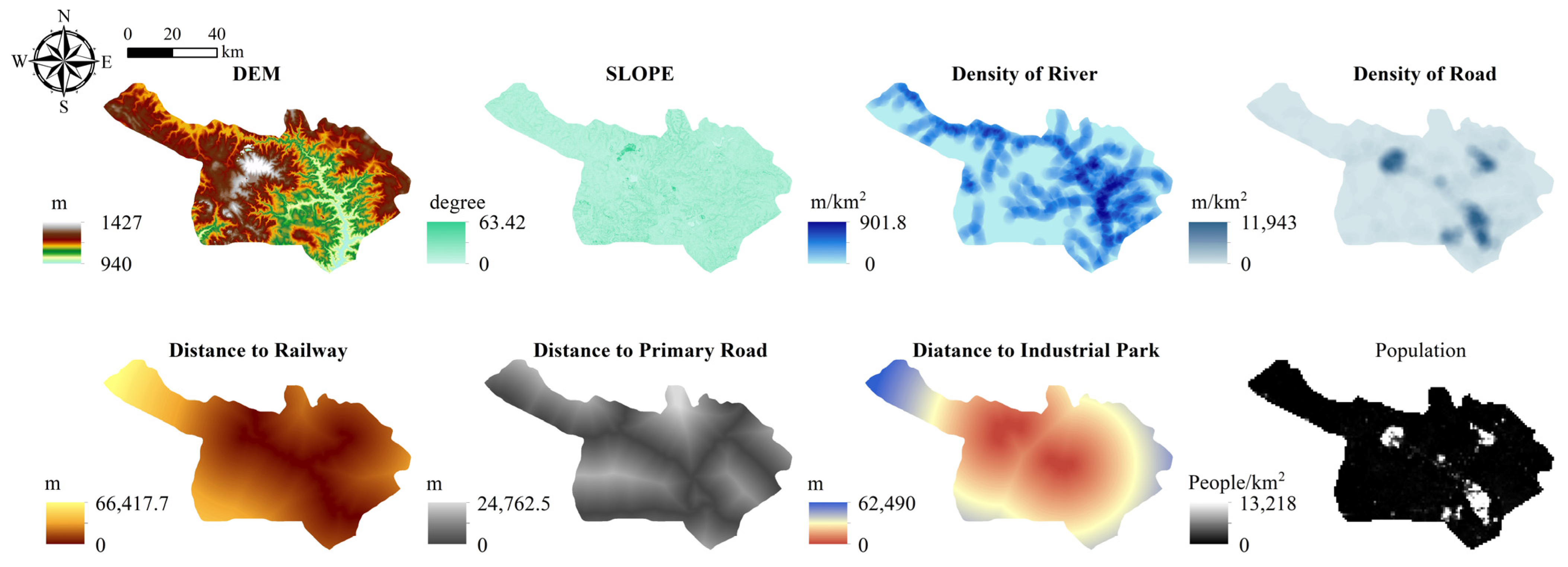
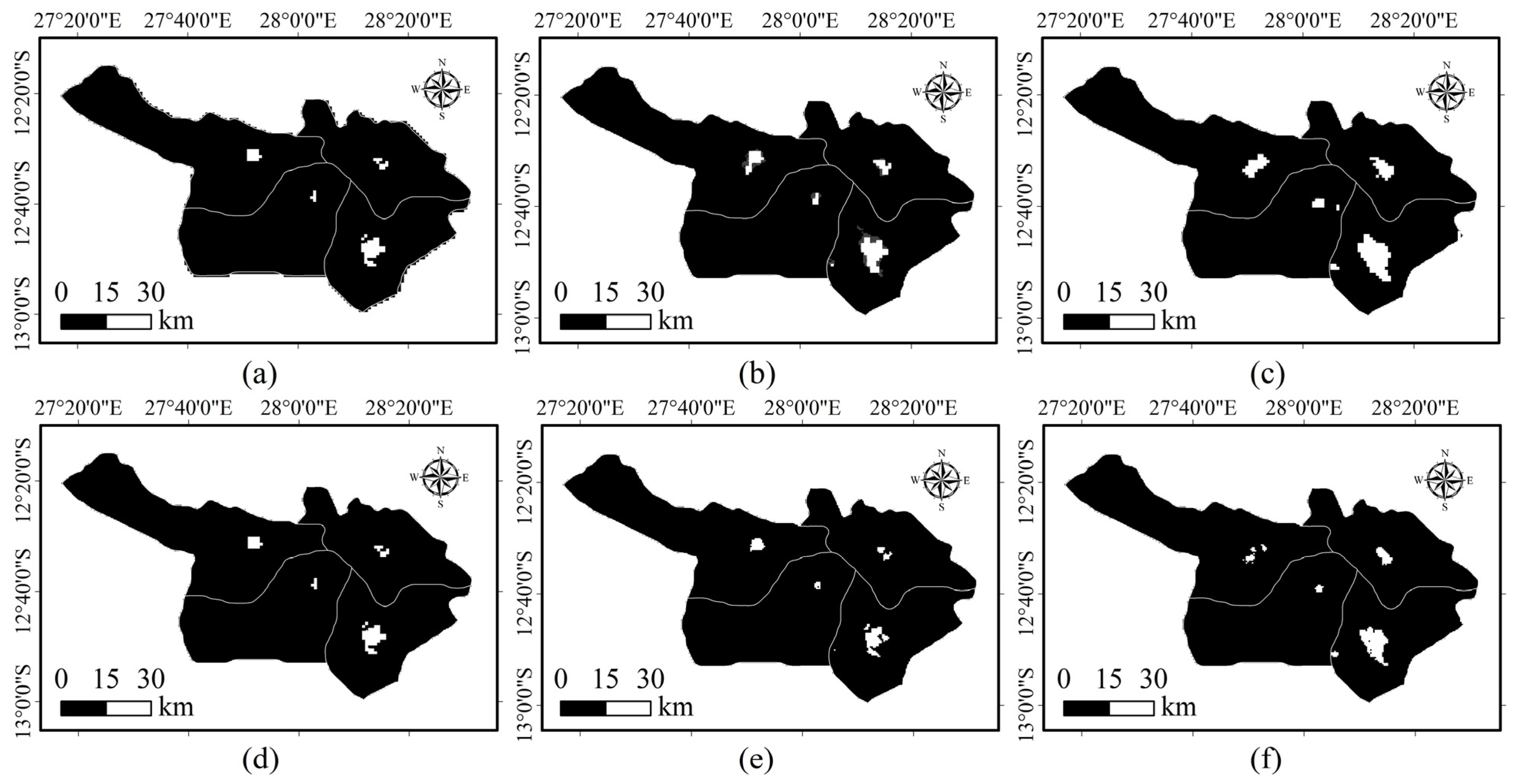
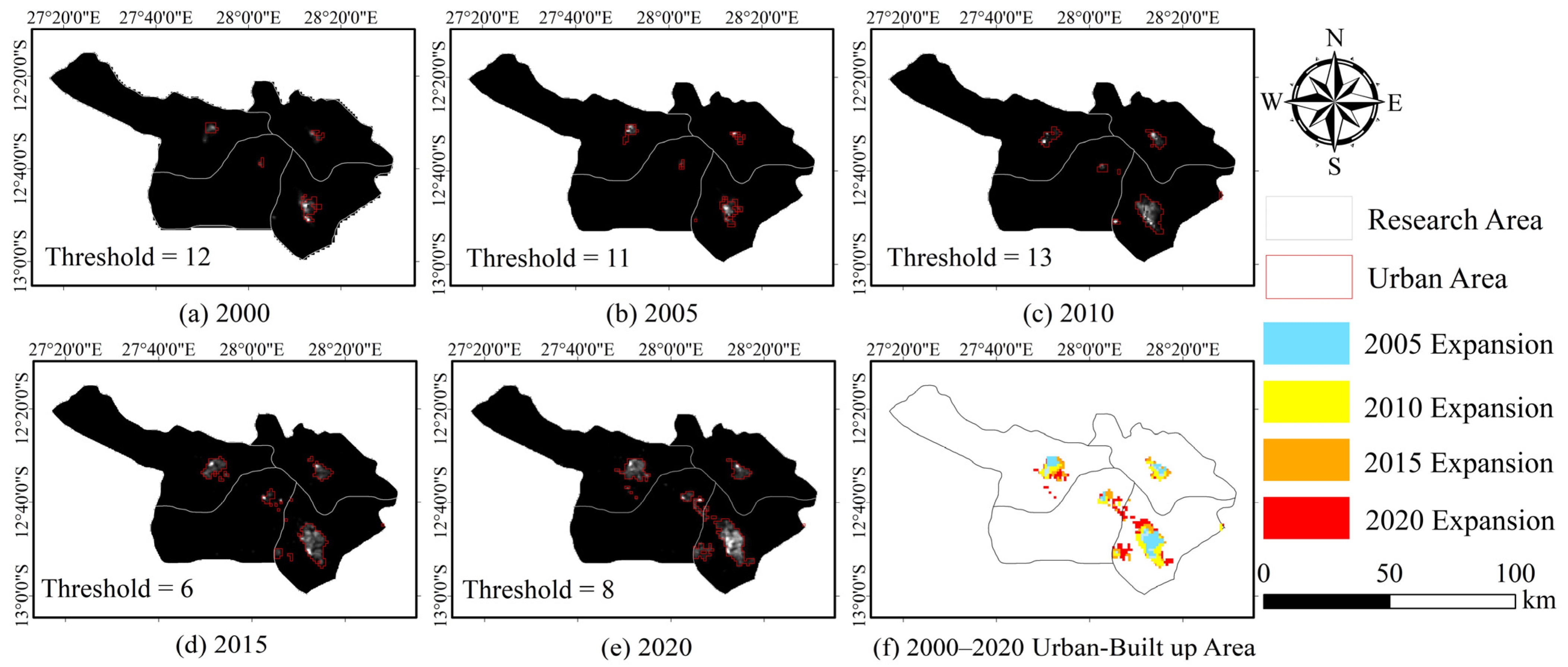

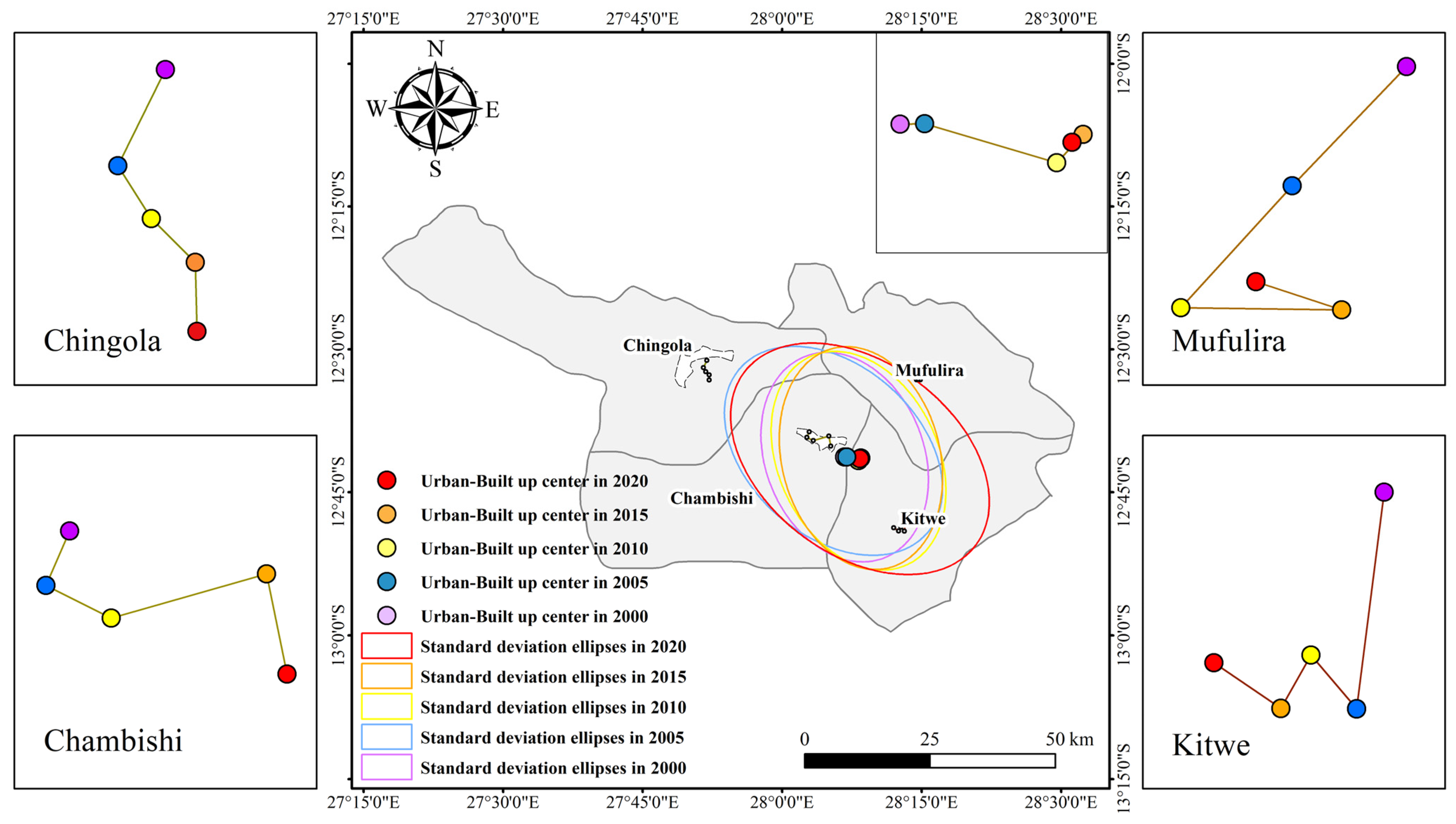

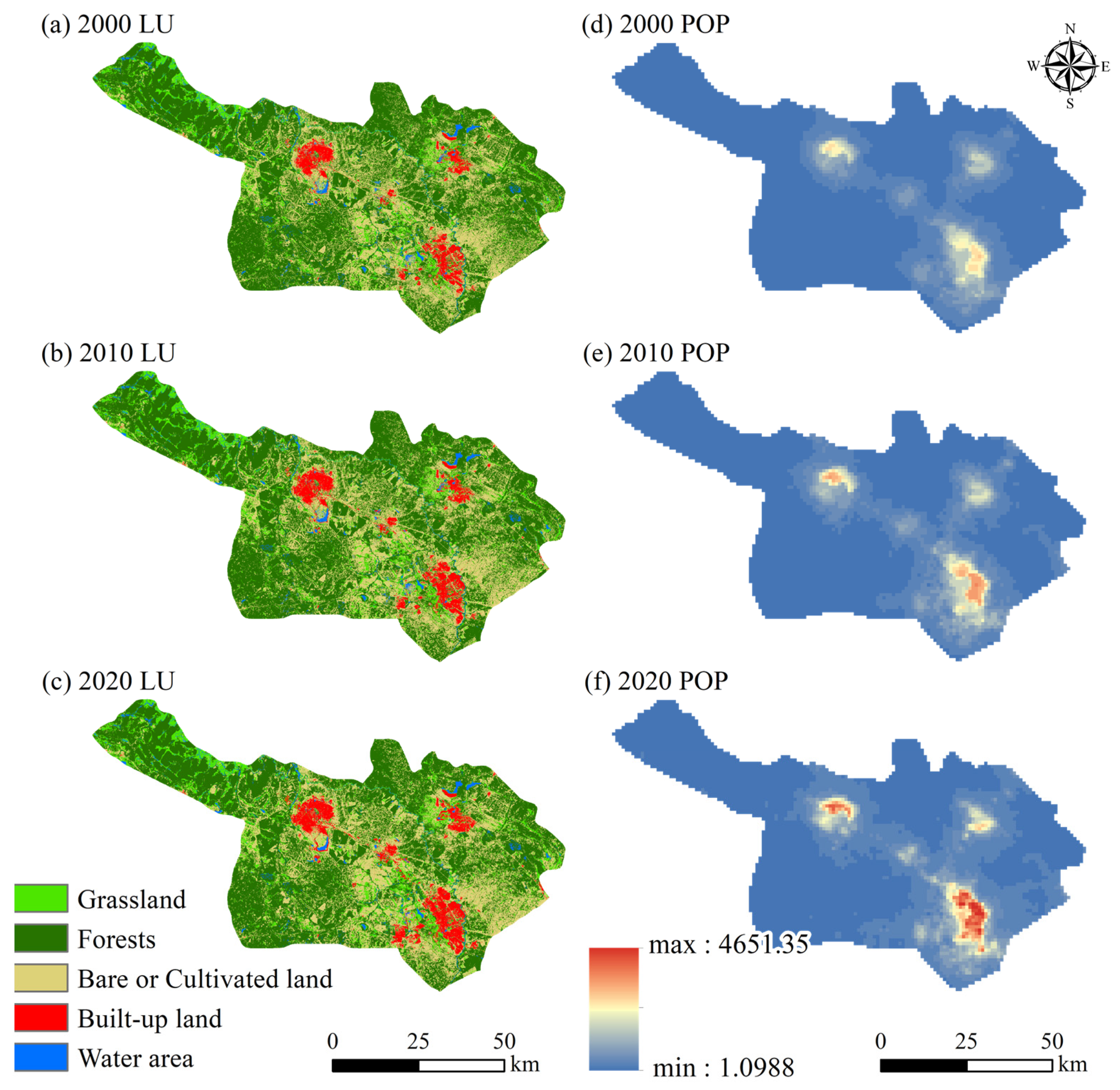
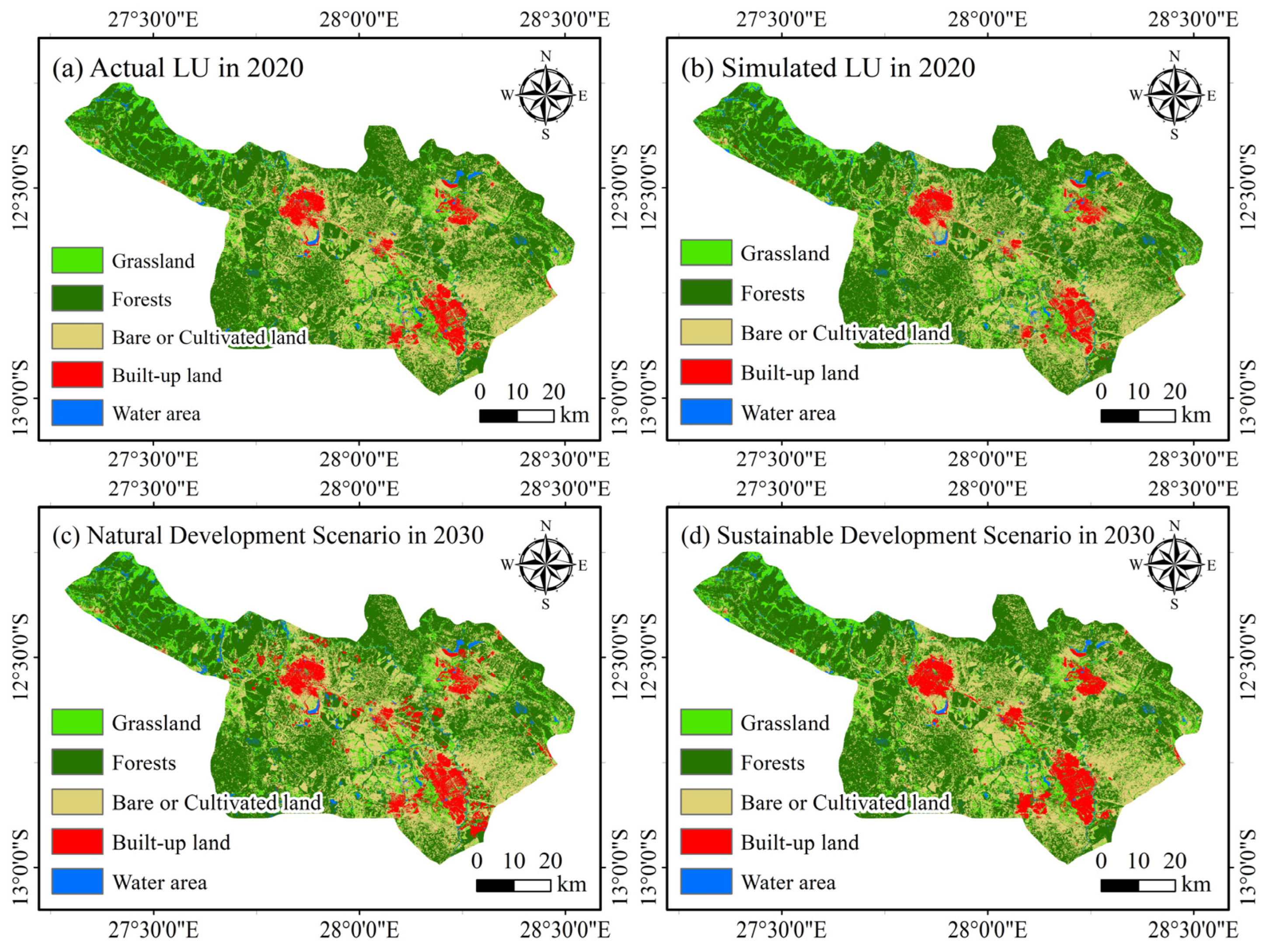
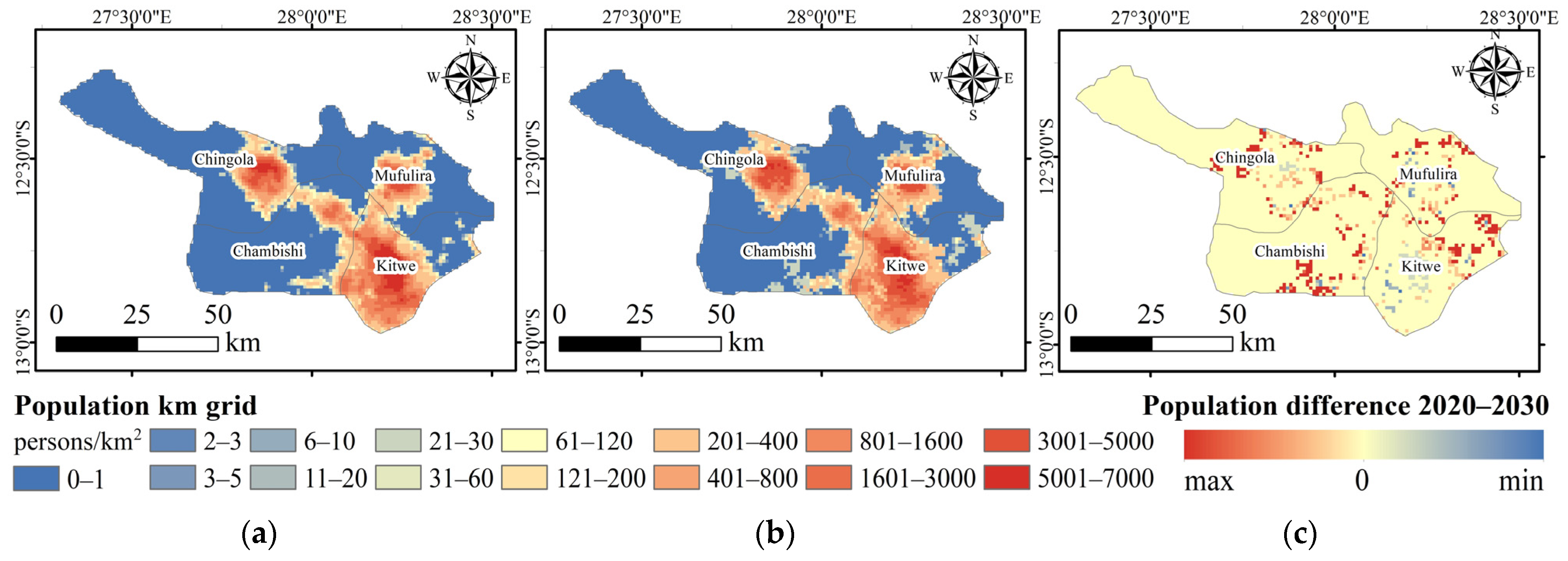
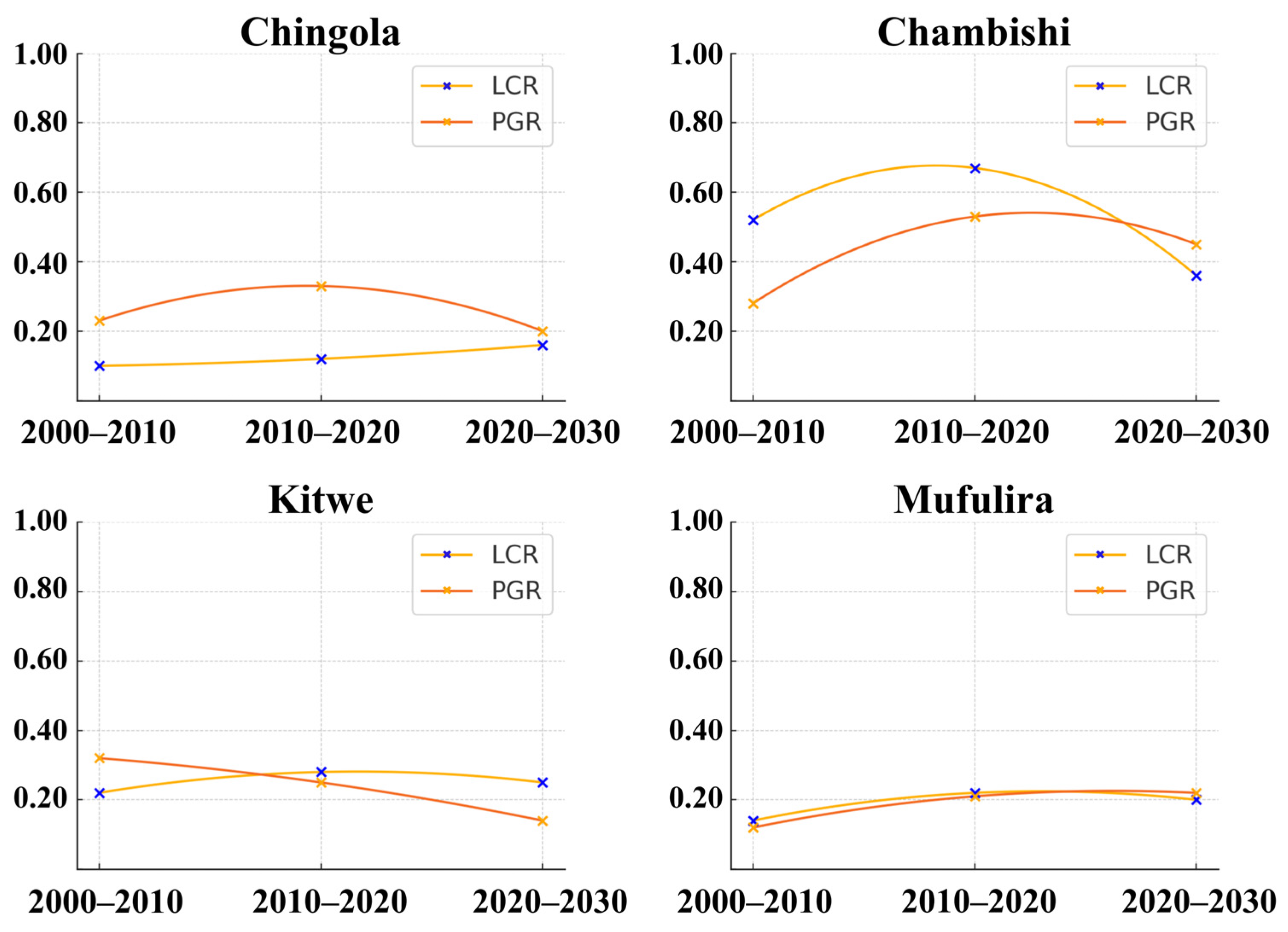
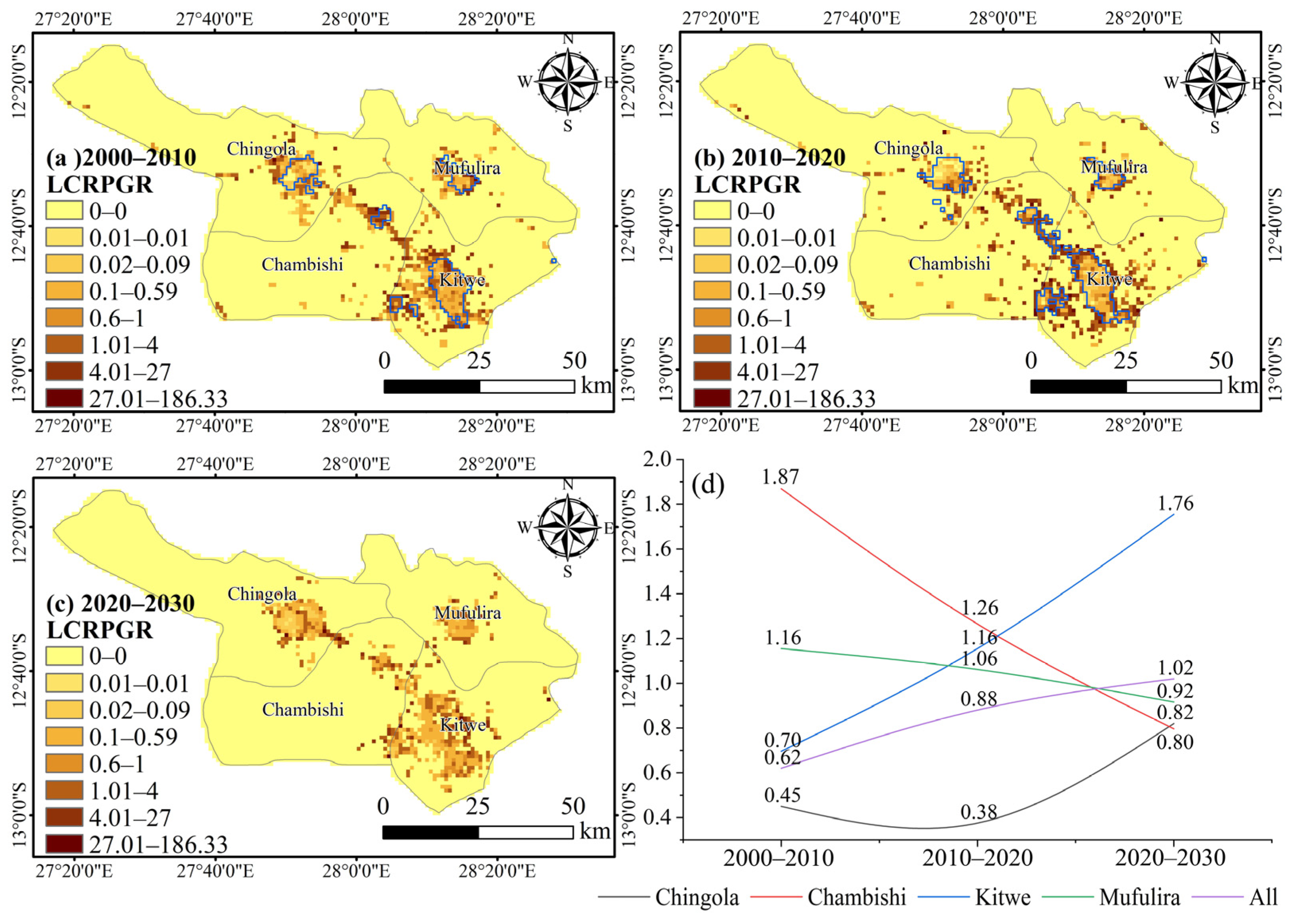
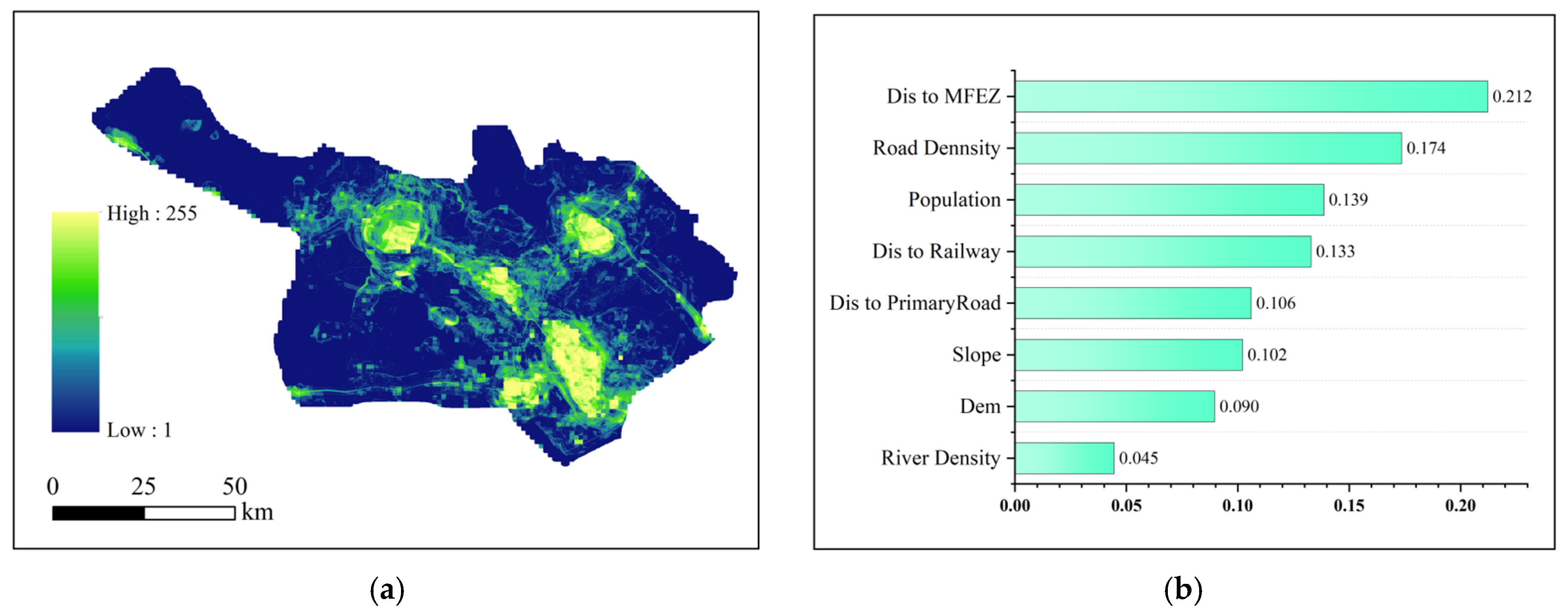
| Data | Description | Year | Source | Data Format |
|---|---|---|---|---|
| Landsat images | LULC Classification | 2000 2010 2020 | Google Earth Engine (GEE) (https://earthengine.google.com/, accessed on 5 March 2024) | GeoTIFF |
| nighttime light data | DMSP-OLS images | 2000–2013 | NOAA/NGDC (https://ngdc.noaa.gov/eog/download.html, accessed on 5 March 2024) | GeoTIFF |
| nighttime light data | NPP-VIIRS images | 2013–2020 | NOAA/NGDC (https://ngdc.noaa.gov/eog/download.html, accessed on 5 March 2024) | GeoTIFF |
| Population grid | Chambishi Mufulira Kitwe Chingola | 2000 2010 2020 | WorldPop (https://www.worldpop.org/, accessed on 5 March 2024) | GeoTIFF |
| Driving factors | DEM Slope River Railway Primary road | 2020 | Google Earth Engine (GEE) (https://earthengine.google.com/, accessed on 5 March 2024) And Open Street Map(OSM) (https://www.openstreetmap.org/, accessed on 5 March 2024) | GeoTIFF Shapefile KML |
| LCRPGR Value | Meaning |
|---|---|
| LCRPGR < −1 | the rate of population decline is greater than the rate of built-up area expansion |
| −1 < LCRPGR ≤ 0 | the rate of population decline is less than the rate of built-up area expansion |
| 0 < LCRPGR ≤ 1 | the rate of population growth is greater than the rate of built-up area expansion |
| 1 < LCRPGR ≤ 2 | the rate of built-up area expansion is 1–2 times the rate of population growth |
| LCRPGR ≤ 2 | the rate of built-up area expansion is greater than 2 times the rate of population growth |
| Method | Year | Overall Accuracy (OA) |
|---|---|---|
| PIFs | 2000 | 0.883 |
| 2005 | 0.931 | |
| 2010 | 0.846 | |
| 2015 | 0.865 | |
| 2020 | 0.876 | |
| STS | 2000 | 0.883 |
| 2005 | 0.721 | |
| 2010 | 0.817 |
| Period | Chingola | Chambishi | Kitwe | Mufulira | |
|---|---|---|---|---|---|
| UEI | 2000–2005 | 0.021 | 0.133 | 0.020 | 0.031 |
| 2005–2010 | 0.114 | 0.320 | 0.200 | 0.227 | |
| 2010–2015 | 0.133 | 0.154 | 0.038 | 0.013 | |
| 2015–2020 | 0.007 | 0.061 | 0.046 | 0.012 | |
| 2000–2020 | 0.100 | 0.450 | 0.111 | 0.088 | |
| UEDI | 2000–2005 | 0.813 | 5.152 | 0.773 | 1.189 |
| 2005–2010 | 0.596 | 1.670 | 1.043 | 1.183 | |
| 2010–2015 | 2.279 | 2.629 | 0.653 | 0.214 | |
| 2015–2020 | 0.216 | 1.804 | 1.357 | 0.349 | |
| 2000–2020 | 0.854 | 3.844 | 0.948 | 0.756 |
| LULC Classes | Area (km2) | Change Rate (%) | |||
|---|---|---|---|---|---|
| 2000 | 2010 | 2020 | 2000–2010 | 2010–2020 | |
| Grassland | 575.8 | 598.8 | 647.3 | 3.99 | 8.11 |
| Forests | 3091.8 | 3029.6 | 2888.7 | −2.01 | −4.65 |
| Bare land and Cultivated land | 1493.6 | 1499.6 | 1536.0 | 0.40 | 2.43 |
| Built-up land | 187.6 | 225.3 | 289.7 | 20.07 | 28.61 |
| Water area | 107.7 | 103.2 | 94.7 | −4.12 | −8.23 |
| Districts | Population | Annual Change Rate (%) | |||
|---|---|---|---|---|---|
| 2000 | 2010 | 2020 | 2000–2010 | 2010–2020 | |
| Chambishi | 75,806 | 100,381 | 170,701 | 3.17 | 6.08 |
| Chingola | 172,026 | 216,602 | 299,936 | 2.59 | 3.68 |
| Kitwe | 376,124 | 517,543 | 661,901 | 3.61 | 2.77 |
| Mufulira | 143,930 | 162,889 | 200,182 | 1.38 | 2.32 |
| Land-Use Types | Grassland | Forests | Bare or Cultivated Land | Built-Up Land | Water Area | Total |
|---|---|---|---|---|---|---|
| Grassland | 642.2 | 3.9 | 0.0 | 1.2 | 0.0 | 647.3 |
| Forests | 51.3 | 2663.7 | 27.3 | 118.7 | 27.6 | 2888.7 |
| Bare or Cultivated land | 0.0 | 0.0 | 1536.0 | 0.0 | 0.0 | 1536.0 |
| Built-up land | 0.0 | 0.0 | 0.0 | 289.7 | 0.0 | 289.7 |
| Water area | 0.0 | 0.0 | 0.4 | 0.0 | 94.4 | 94.7 |
| Total | 693.5 | 2667.6 | 1563.7 | 409.6 | 122.0 | 0.0 |
| Land-Use Types | Grassland | Forests | Bare or Cultivated Land | Built-Up Land | Water Area | Total |
|---|---|---|---|---|---|---|
| Grassland | 647.3 | 0.0 | 0.0 | 0.0 | 0.0 | 647.3 |
| Forests | 28.9 | 2699.4 | 152.3 | 8.0 | 0.1 | 2888.7 |
| Bare or Cultivated land | 17.3 | 58.2 | 1394.9 | 65.5 | 0.1 | 1536.0 |
| Built-up land | 0.0 | 0.0 | 0.0 | 289.7 | 0.0 | 289.7 |
| Water area | 0.0 | 0.0 | 7.5 | 0.1 | 87.2 | 94.7 |
| Total | 693.5 | 2757.6 | 1554.7 | 363.3 | 87.4 | 0.0 |
| Districts | Population | Annual Change Rate (%) | |
|---|---|---|---|
| 2020 | 2030 | 2020–2030 | |
| Chambishi | 170,701 | 267,686 | 4.60 |
| Chingola | 299,936 | 365,479 | 1.99 |
| Kitwe | 661,901 | 761,511 | 1.41 |
| Mufulira | 200,182 | 249,561 | 2.23 |
| Districts | 2000–2010 | 2010–2020 | 2020–2030 | ||||||
|---|---|---|---|---|---|---|---|---|---|
| LCR | PGR | LCRPGR | LCR | PGR | LCRPGR | LCR | PGR | LCRPGR | |
| Chingola | 0.10 | 0.23 | 0.45 | 0.12 | 0.33 | 0.38 | 0.16 | 0.20 | 0.82 |
| Chambishi | 0.52 | 0.28 | 1.87 | 0.67 | 0.53 | 1.26 | 0.36 | 0.45 | 0.80 |
| Kitwe | 0.22 | 0.32 | 0.70 | 0.28 | 0.25 | 1.16 | 0.25 | 0.14 | 1.76 |
| Mufulira | 0.14 | 0.12 | 1.16 | 0.22 | 0.21 | 1.06 | 0.20 | 0.22 | 0.92 |
Disclaimer/Publisher’s Note: The statements, opinions and data contained in all publications are solely those of the individual author(s) and contributor(s) and not of MDPI and/or the editor(s). MDPI and/or the editor(s) disclaim responsibility for any injury to people or property resulting from any ideas, methods, instructions or products referred to in the content. |
© 2024 by the authors. Licensee MDPI, Basel, Switzerland. This article is an open access article distributed under the terms and conditions of the Creative Commons Attribution (CC BY) license (https://creativecommons.org/licenses/by/4.0/).
Share and Cite
Huang, Y.; Ming, D. SDG 11.3 Assessment of African Industrial Cities by Integrating Remote Sensing and Spatial Cooperative Simulation: With MFEZ in Zambia as a Case Study. Remote Sens. 2024, 16, 2995. https://doi.org/10.3390/rs16162995
Huang Y, Ming D. SDG 11.3 Assessment of African Industrial Cities by Integrating Remote Sensing and Spatial Cooperative Simulation: With MFEZ in Zambia as a Case Study. Remote Sensing. 2024; 16(16):2995. https://doi.org/10.3390/rs16162995
Chicago/Turabian StyleHuang, Yuchen, and Dongping Ming. 2024. "SDG 11.3 Assessment of African Industrial Cities by Integrating Remote Sensing and Spatial Cooperative Simulation: With MFEZ in Zambia as a Case Study" Remote Sensing 16, no. 16: 2995. https://doi.org/10.3390/rs16162995
APA StyleHuang, Y., & Ming, D. (2024). SDG 11.3 Assessment of African Industrial Cities by Integrating Remote Sensing and Spatial Cooperative Simulation: With MFEZ in Zambia as a Case Study. Remote Sensing, 16(16), 2995. https://doi.org/10.3390/rs16162995








